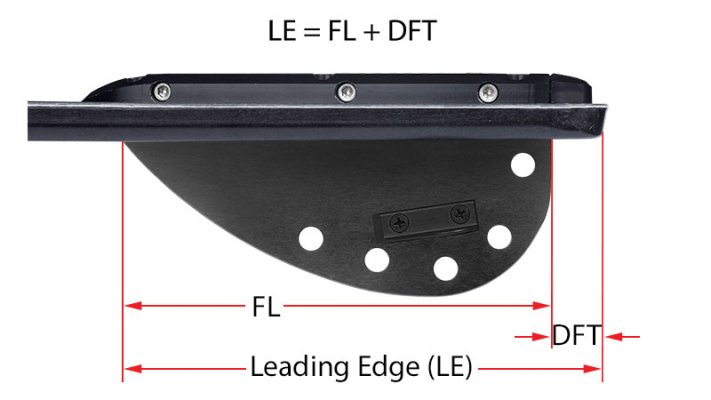Advanced, Fin, Setup, Ski Behavior
Fin Length vs. Leading Edge
It’s commonly believed that fin length is a measure of tip-sensitivity, e.g. making fin length longer will make it easier to engage more of the water ski’s tip—especially during offside turns. But this is not always true.
The only time an FL adjustment affects tip-sensitivity predictably is when it happens to move LE in the same direction and by the same amount. It’s the fin’s leading edge location that affects tip-engagement, not the fin’s length. So the more accurate statement would be that the further forward the fin’s leading edge is on a ski, the easier tip-engagement will be.
Before going any further, here’s a quick review of three key terms:
- Fin Length (FL) – FL is the length of the fin where it intersects the water ski’s base.
- Distance From Tail (DFT) – DFT is the distance from the back of the fin to the ski’s tail.
- Leading Edge (LE) – LE represents where the fin’s leading edge is located on the ski, and is the sum of the FL and DFT measurements.

It’s easy to understand why fin length (FL) is so commonly credited with having control over a ski’s tip behavior. Most FL adjustments maintain a constant distance from tail measurement (DFT). If DFT remains constant, then the fin’s leading edge (LE) location changes by the full amount of the FL adjustment. But technically, it is the LE change that affects tip-engagement, not how long or short the fin becomes.
The biggest problem with using FL as a measure of tip-sensitivity is that LE can change independently of FL. For example, if we were to move the whole fin forward by increasing DFT, there would be no change to FL, but tip-sensitivity would increase because LE moved forward on the ski. Similarly, if we increased DFT without moving LE (accomplished by rotating the leading edge of the fin up into the ski), we will have shortened FL without any effect to tip-sensitivity because LE didn’t move.
There’s even a scenario where decreasing FL results in increased tip-sensitivity. If LE is moved forward on the ski by .005” and DFT is increased by more than that, say .010”, we would have a shorter fin that delivers increased tip-sensitivity—exactly the opposite of the widely held misconception that making FL shorter will reduce tip-sensitivity.
Keep in mind that all of these changes will also affect how the tail of the ski drifts while turning, but smear is another discussion. The point to remember here is that FL on its own is just an out-of-context measurement that means nothing unless we also consider what is happening with DFT. The best way to include DFT information in changes we are considering is to calculate changes to fin’s leading edge location. Since LE includes both FL and DFT information, LE is the most dependable and revealing measure of tip-sensitivity we can use.
Think of FL as nothing more than a measurement, not as an actual adjustment of any water ski behavior. If we want to speak accurately about managing tip-sensitivity, we have to speak in terms of LE—the location of the fin’s leading edge.
Note: If you find any of this a little confusing, rest assured that these concepts are all methodically explained and presented in an orderly fashion that anyone can follow in the book Fin Whispering—Demystifying the Black Art of Water Ski Tuning.
SkiJay
![]()

